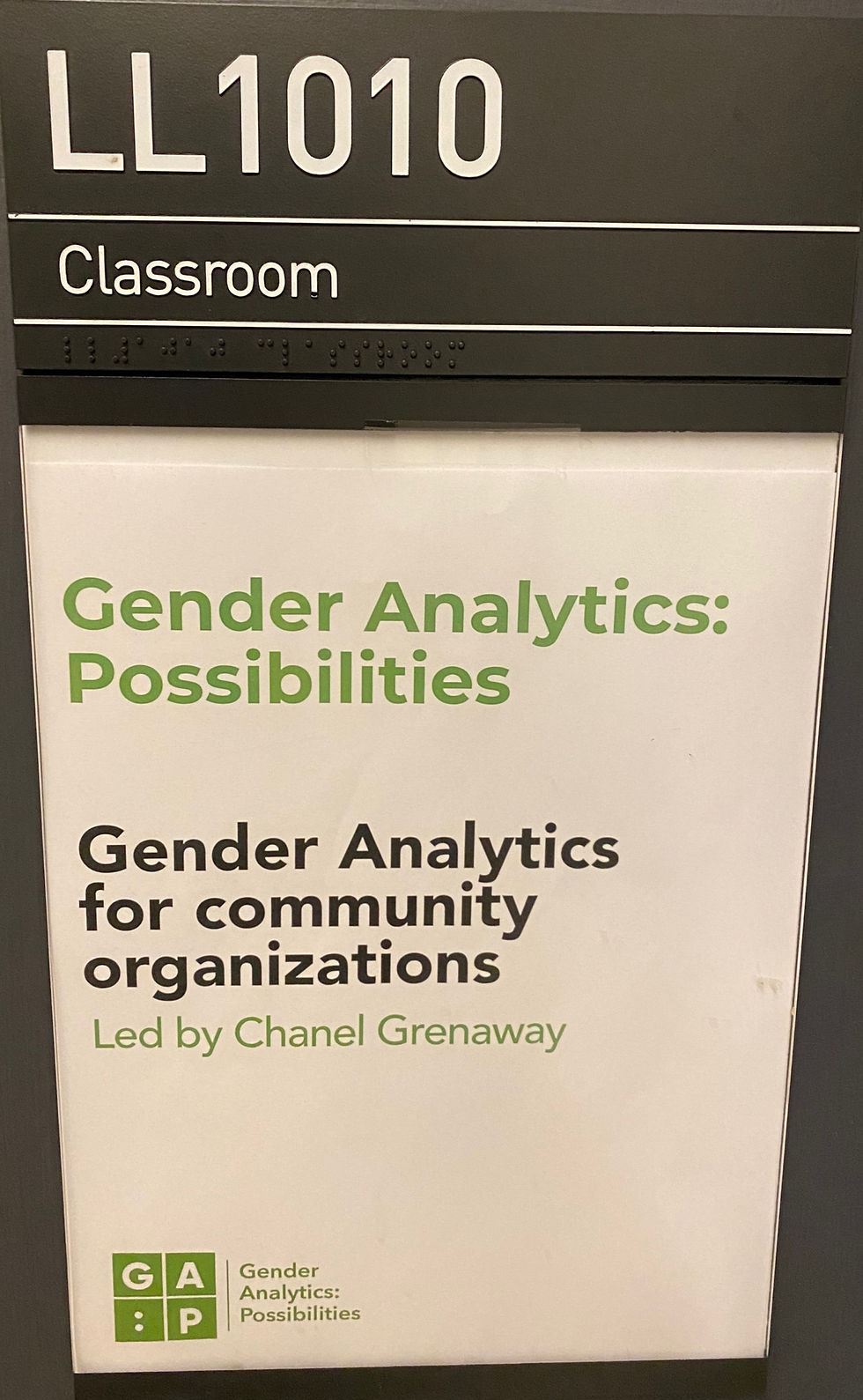Retrospective: Gender Analytics: Possibilities Conference
- Chanel Grenaway
- May 5, 2023
- 4 min read
There is a desire to get to the “how to” of gender analytics but the “why and what” clarifies the context and fuels the motivation that will keep us consistent and accountable.

Last week I attended the Gender Analytics: Possibilities conference both as a participant and workshop facilitator. The first day was dedicated to several compelling and insightful engaging and thought provoking panel conversations which covered topics from gender analytics (GA) in artificial intelligence to GA in the design of contracts, in the financial services sector and in sports analytics. We heard from a diversity of speakers that shared intellectually expanding insights that challenged the idea of business as usual.
Interestingly enough, when it came time for questions from the audience, I would say that 95% of the questions started with “how do we enact change or how might we engage in gender analytics or creating more inclusive processes that…” Members of both the in-person and virtual audience wanted to get straight to the steps and solutions – how do we improve gender inequities and how do we solve for this in our day-to-day work?
I am not surprised by the desire to move to action, solution-finding and the ‘how to’. When I worked with the Dr. Sarah Kaplan and the team at the Institute for Gender and the Economy in 2019, we conducted a study where we interviewed members of the private sector, public sector and nonprofit sector about their experience and knowledge of gender analysis. We learned that there is a need for skills and capacity building related to the practice of gender analysis. Understanding the concept of GA in theory and conceptually is one thing, but a gap exists when it comes to integrating GA into your work processes, thinking and structures.
Fast forward to April 2023, and the same challenges and struggles exist. While I agree it is extremely important to get to the how to, and the testing and piloting of more inclusive solutions, I also believe that grounding this work in the right framing of the problem and deepening our understanding of systemic barriers and the experiences of under-served communities is critical to solution design. Focusing on the why and the core issues is also valuable when you are trying to integrate GA as a consistent and sustained practice within teams and in organizations.
“If I were given one hour to save the planet, I would spend 59 minutes defining the problem and one minute resolving it,” Albert Einstein
Exploring and redefining the problem is a vital first step in gender analysis. It is a crucial first task because if you start with a problem that is based solely on your own lived experiences and/or default way of thinking, you are likely to create a solution that is based solely on your own lived experience and business as usual. Examining the problem with a diverse group of people or with a multiple of diverse team members, can help to expand your thinking about the context and issues and enable you to better understand the actual experiences of your end users or the community that you wish to engage. Collaborating with community or engaging in participatory community practices offer opportunities to check assumptions, validate hypotheses, and can create space for innovation in a way that is more inclusive. During the conference we heard different ideas related to reframing concepts or problem statements for example (I’m paraphrasing here):
“Super token” — the ability to survive and adapt in a system that is meant to oppress you. – Elizabeth (Dori) Tunstall, Dean, Faculty of Design, OCAD University
We assumed we can point money at women without changing anything else. — Joy Anderson, Founder and President, Criterion Institute
There is a strong financial incentive to move as fast as you can, to be first — with this we lose trust building and relationship building with community, how does all of this money influence the way AI is designed? – Allison Cohen, Senior Applied AI Projects Manager, Mila
All of these statements help us to think about the impacts of the practices we are applying, and again helps us to stop, reflect and ask ourselves is this what we want and is this how we want to work? In my own work I was reminded of workplace initiatives where inclusion, equity and diversity are being reframed as a health and safety issue, which opens up new conversations regarding the role and responsibilities of employers, and unions. Gender analytics is all about challenging the idea of business as usual and it starts with examining the problem statement and gaining more clarity on the context which helps to challenge our ideas and the status quo ways of working.

During a conference I found myself asking additional why and what questions, for example why aren't organizations and institutions creating more space for reflective thinking, and using gender and equity analysis as a tool for innovation and creativity? What does joy look like in this space and how can we bring joy to this pivotal work? Why are organizations still missing the mark when it comes to engaging
with community or their staff?
I think that it is extremely important that we get to the how to and the inclusive solutions, that we develop our capacity to do gender analytics AND I think it's equally important that we gain a deeper understanding of the context of our work, the systems we are working in, the lived and living experiences of under-served communities and the belief systems that are creating harm. As they say, if you can’t name it, you can’t change it.
If you want support as you explore your why, what and how to of gender analytics or racial equity and justice, don't hesitate to connect with me.
